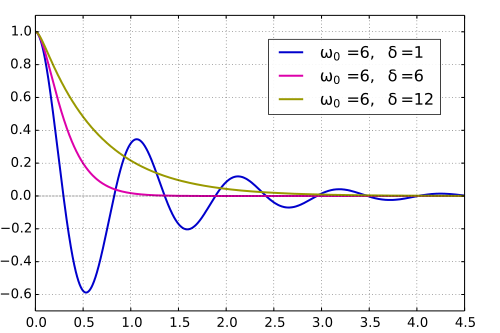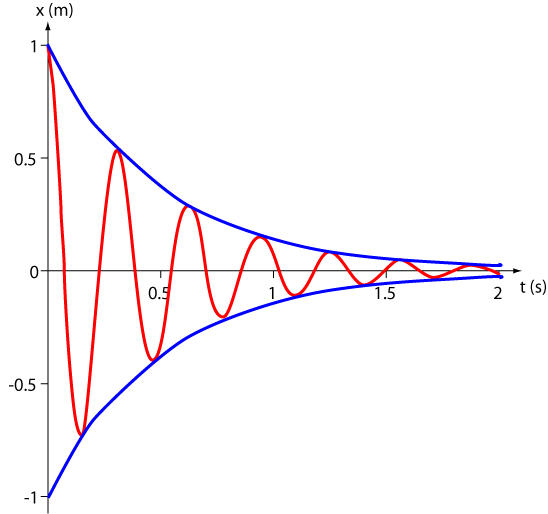Difference Between Damped and Undamped Oscillations
Every object, every particle and every system oscillates in its own natural frequency or set of frequencies. The natural frequency of an object is the frequency at which the object tends to vibrate or oscillate without any external force applied. All these objects and particles require a source of energy at a specific frequency ranging from few Hz to several MHz. This requirement can be fulfilled by an electronic device called an oscillator. It’s an electronic circuit used to generate a signal and is commonly found in computers, wireless receivers and transmitters, instrumentation systems, and all kinds of electronic systems. It simply produces periodic oscillations in the form of electrical or mechanical energy.
An oscillator can produce sinusoidal or non-sinusoidal waveforms. Basically oscillators are categorized into two main types – sinusoidal and non-sinusoidal oscillators. In this article, we’ll focus only on sinusoidal oscillators. An oscillator which produces a sine-wave output is a sinusoidal oscillator. They are classified according to their frequency-determining components. The oscillations generated by sinusoidal oscillators may be categorized as damped and undamped oscillations. The friction in an oscillating system is referred to as damping. Let’s take a look at the two types of vibrations and point out the key points comparing the two.

What is Damped Oscillations?
The electronic oscillations whose amplitude goes on decreasing with time due to the losses inherent in the electrical system in which oscillations are generated are called damped oscillations. It refers to an oscillation that fades away with time. An oscillator is always subject to forces, which dissipate a part of the oscillator energy as heat, or in other forms. As the energy is proportional to the square of the amplitude, the amplitude decreases gradually until the oscillator returns to equilibrium. The oscillator circuits then produce the damped oscillations. However, the frequency of oscillation remains unchanged because it depends on the circuit parameters. The best example of a damped oscillation is a swinging pendulum, in which the vibration slows down and stops over time.

What is Undamped Oscillations?
If the losses incurred in the electrical system could be compensated, the amplitude of oscillation would remain constant and as such the oscillation would continue indefinitely against both external disturbances and changes in the initial conditions. This type of oscillation is called undamped oscillation. So, simply put, the oscillations whose amplitude remains constant with time are called undamped oscillations. Systems which can generate such oscillations are called self-excited oscillating systems and they are maintained by an external energy source in a non-linear dissipative system. If the oscillator produces undamped oscillations, then there are no power losses or provisions to compensate for the power losses.
Difference between Damped and Undamped Oscillations
Meaning of Damped and Undamped Oscillations
The oscillations generated by sinusoidal oscillators may be categorized as damped and undamped oscillations. The electronic oscillations whose amplitude goes on decreasing with time due to the losses inherent in the electrical system in which oscillations are generated are called damped oscillations. However, if the losses incurred in the electrical system could be compensated, the amplitude of oscillation would remain constant and as such the oscillation would continue indefinitely against both external disturbances and changes in the initial conditions. This type of oscillation is called undamped oscillation.
Energy Loss in Damped vs. Undamped Oscillations
In damped oscillations, the amplitude of the generated wave gradually decreases with time because the power loss is not compensated. Such type of oscillations does not continue for a longer time and finally, it ceases. Where there is loss of energy, the motion becomes damped. On the contrary, if the oscillator circuit produces undamped oscillations, then there are no power losses or provision to compensate the power losses. They have constant amplitude oscillations, meaning the amplitude does not fall with time, so there is no loss of energy.
Cause
Damping is progressive diminution of amplitude of oscillations in an oscillatory system, caused by dissipation of stored energy. Damping results from friction of the fluid moving within the tubing which tends to extinguish any oscillations and decrease the frequency response of the transducer system. Typically all types of vibrations are more or less damped, so it is necessary to compensate the energy losses by supplying additional energy from an external agency to make the oscillations undamped. Any energy supplied from the outside should be in phase with the oscillations set up.
Damped vs. Undamped Oscillations: Comparison Chart

Summary of Damped vs. Undamped Oscillations
In a nutshell, the main difference between damped and undamped oscillations is that in damped oscillations, the amplitude of the generated wave gradually decreases over time, whereas the amplitude of the generated wave does not change with time, in case of undamped oscillations. Where there is loss of energy, the motion becomes damped. On the contrary, if the oscillator circuit produces undamped oscillations, then there are no power losses or provision to compensate the power losses. Damping is progressive diminution of amplitude of oscillations in an oscillatory system, caused by dissipation of stored energy. Generally all types of vibrations are more or less damped, so it is necessary to compensate the energy losses by supplying additional energy from an external agency to make the oscillations undamped.
- Difference Between Caucus and Primary - June 18, 2024
- Difference Between PPO and POS - May 30, 2024
- Difference Between RFID and NFC - May 28, 2024
Search DifferenceBetween.net :
2 Comments
Leave a Response
References :
[0]Singh, M.D. and J.G. Joshi. Mechatronics. New Delhi, India: Prentice Hall of India, 2006. Print
[1]Tandon, Rakesh. Structured Oral Examination Practice for the Final FRCA. Oxford, United Kingdom: Oxford University Press, 2011. Print
[2]Groszkowski, Janusz. Frequency of Self-Oscillations. Amsterdam, Netherlands: Elsevier, 2013. Print
[3]Rabinovich, M.I. and D.I. Trubetskov. Oscillations and Waves: In Linear and Nonlinear Systems. Abingdon, United Kingdom: Taylor & Francis, 1989. Print
[4]Image credit: https://commons.wikimedia.org/wiki/File:Underdamped_oscillation_xt.png
[5]Image credit: https://upload.wikimedia.org/wikipedia/commons/thumb/1/16/Mplwp_damped_oscillations.svg/500px-Mplwp_damped_oscillations.svg.png

Thankyou
Very informative